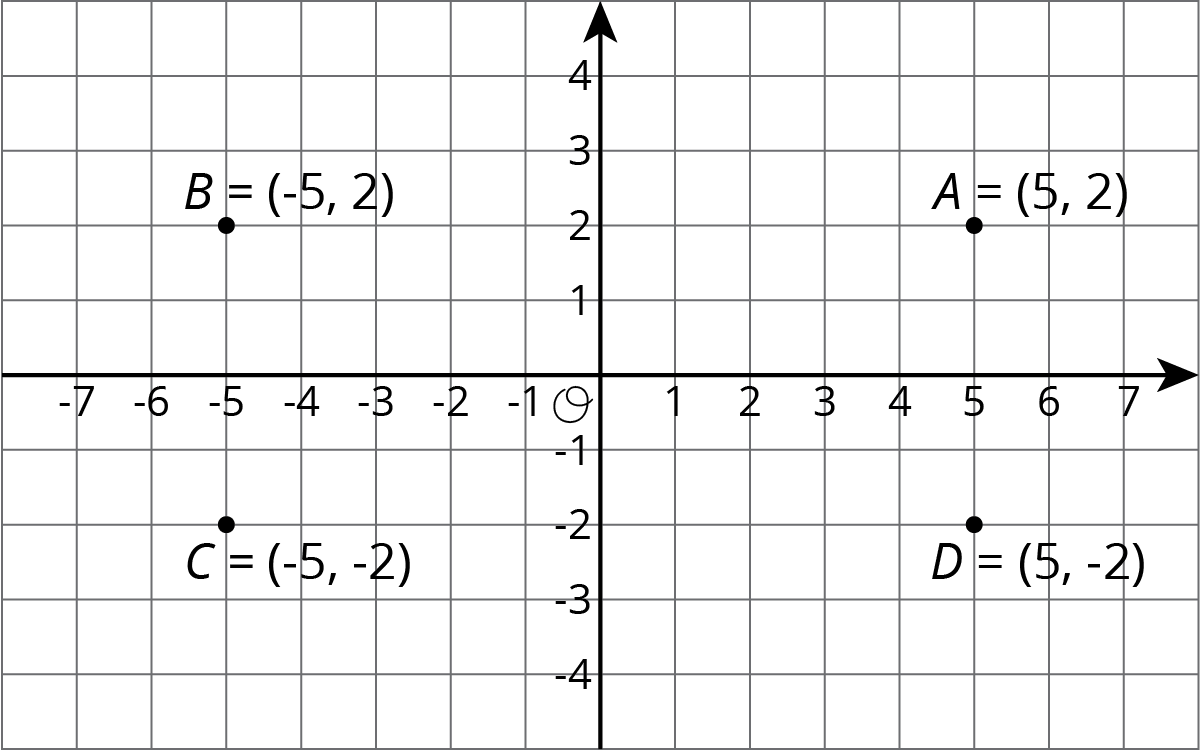Lesson 14
Distances on a Coordinate Plane
Let’s explore distance on the coordinate plane.
14.1: Coordinate Patterns
Plot points in your assigned quadrant and label them with their coordinates.
14.2: Signs of Numbers in Coordinates
-
Write the coordinates of each point.
- \(A=\)
- \(B=\)
- \(C=\)
- \(D=\)
- \(E=\)
-
Answer these questions for each pair of points.
- How are the coordinates the same? How are they different?
- How far away are they from the y-axis? To the left or to the right of it?
- How far away are they from the x-axis? Above or below it?
-
\(A\) and \(B\)
-
\(B\) and \(D\)
-
\(A\) and \(D\)
Pause here for a class discussion.
-
Point \(F\) has the same coordinates as point \(C\), except its \(y\)-coordinate has the opposite sign.
- Plot point \(F\) on the coordinate plane and label it with its coordinates.
- How far away are \(F\) and \(C\) from the \(x\)-axis?
- What is the distance between \(F\) and \(C\)?
-
Point \(G\) has the same coordinates as point \(E\), except its \(x\)-coordinate has the opposite sign.
- Plot point \(G\) on the coordinate plane and label it with its coordinates.
- How far away are \(G\) and \(E\) from the \(y\)-axis?
- What is the distance between \(G\) and \(E\)?
-
Point \(H\) has the same coordinates as point \(B\), except both of its coordinates have the opposite signs. In which quadrant is point \(H\)?
14.3: Finding Distances on a Coordinate Plane
-
Label each point with its coordinates.
-
Find the distance between each of the following pairs of points.
-
Point \(B\) and \(C\)
-
Point \(D\) and \(B\)
-
Point \(D\) and \(E\)
-
- Which of the points are 5 units from \((\text-1.5, \text-3)\)?
- Which of the points are 2 units from \((\text0.5, \text-4.5)\)?
- Plot a point that is both 2.5 units from \(A\) and 9 units from \(E\). Label that point \(F\) and write down its coordinates.
Priya says, “There are exactly four points that are 3 units away from \((\text- 5, 0)\).” Lin says, “I think there are a whole bunch of points that are 3 units away from \((\text- 5, 0)\).”
Do you agree with either of them? Explain your reasoning.
Summary
The points \(A = (5, 2), \,B = (\text-5, 2), \, C = (\text-5, \text-2)\), and \(D=(5, \text-2)\) are shown in the plane. Notice that they all have almost the same coordinates, except the signs are different. They are all the same distance from each axis but are in different quadrants.

Notice that the vertical distance between points \(A\) and \(D\) is 4 units, because point \(A\) is 2 units above the horizontal axis and point \(D\) is 2 units below the horizontal axis. The horizontal distance between points \(A\) and \(B\) is 10 units, because point \(B\) is 5 units to the left of the vertical axis and point \(A\) is 5 units to the right of the vertical axis.
We can always tell which quadrant a point is located in by the signs of its coordinates.
| \(x\) | \(y\) | quadrant |
|---|---|---|
| positive | positive | I |
| negative | positive | II |
| negative | negative | III |
| positive | negative | IV |

In general:
- If two points have \(x\)-coordinates that are opposites (like 5 and -5), they are the same distance away from the vertical axis, but one is to the left and the other to the right.
- If two points have \(y\)-coordinates that are opposites (like 2 and -2), they are the same distance away from the horizontal axis, but one is above and the other below.
When two points have the same value for the first or second coordinate, we can find the distance between them by subtracting the coordinates that are different. For example, consider \((1,3)\) and \((5,3)\):

They have the same \(y\)-coordinate. If we subtract the \(x\)-coordinates, we get \(5-1=4\). These points are 4 units apart.
Glossary Entries
- quadrant
The coordinate plane is divided into 4 regions called quadrants. The quadrants are numbered using Roman numerals, starting in the top right corner.
